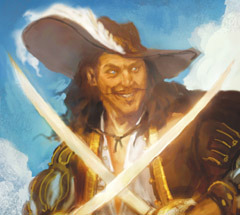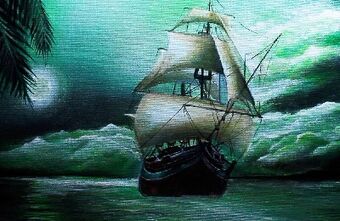Enriqué D'Andalucia
Enriqué D'Andalucia | |
|---|---|
 Enriqué D'Andalucia | |
| Birth name | Unknown |
| Nickname(s) | Le Lopo |
| Born | Unknown, believed to be around 1800 |
| Died | 1859 Nuvea Lyon, Inyursta |
| Buried | Nuvea Lyon, Inyursta |
| Allegiance |
|
| Service/ | |
| Years of service | 1837 - 1854 |
| Rank | Admiràle |
| Battles/wars | |
| Relations | Martina D'Andalucia, Descendant |
Enriqué D'Andalucia, also known as "Le Lopo" (The Wolf) was a 19th century pirate and later naval commander under the flag of Inyursta.
Early Life
Little is known about Enriqué's early life or upbringing. In fact, it is unknown if Enriqué was even his birthname; however by all historical accounts it is generally believed he was from southern Eulabia. Around 1820 it is believed that he came to the pirate republic calling itself "The Free State of Hopewell", and hopped around several crews before coming under the tutelage of Philipé Cousteau.
Piracy
The early origins of D'Andalucia's piracy are unknown. First records mentioning "El Lobo" only come about after he was a prominent and charismatic crew member on Cousteau's ship. Because of this, it is hard for historians to know the full extent of his piracy career.
Under Cousteau
Enriqué served as a deck officer under Cousteau, and within a few seasons had quickly became first mate on The Vengeance. Like his mentor and captain, Enriqué was fearless in battle, and was known for personally leading his men in boarding parties. After the capture of "La Santa Clara" off the coast of Chuchara in 1827, he was given command of the vessel which was renamed "La Espada".
Cousteau was captured by [PLACEHOLDER] authorities two years later in Porté Sant-Yves, while Enriqué D'Andalucia along with most of the crew were able to escape. Authorities kept Cousteau imprisoned in a remote single-cell prison somewhere deep in the swamps of north-western Marindino while they hunted for D'Andalucia and his crew. In 1832 Philipé the Fierce was hung in Nuveau Lyon with little public forewarning of the event. Following the death of their captain, the crew naturally selected D'Andalucia as their new commander and embarked on a war of vengeance against British interests in Inyursta.
As Captain
D'Andalucia led the crews of The Vengeance and La Espada on a merciless campaign of terror; sinking ships, burning plantations and pillaging several coastal settlements. The Pirates raided the [PLACEHOLDER] port of New Cornwall (now Porté Cocha), and completely burnt the town to the ground. This war of revenge caused a marked response from the British, who increased their naval presence in the open waters and forced D'Andalucia to retreat back into the reefs and backwaters of the San Meresque Strip.
War of Independence
In 1837, Enriqué D'Andalucia was hired to transport republican leader Bernardo Lafayette from Marindino to Borasoles. Historical records have not been able to indicate how exactly he came into contact with Lafayette; however theories range from sympathetic smugglers to D'Andalucia himself seeking out Lafayette due to his hatred of the [PLACEHOLDER]. "Le Lopo" and his crew proved invaluable in the defense of Borasoles when they ambushed, grounded and looted a British man-of-war; thus taking the ship out of the fight and securing more cannons for the republican forces.
After the success of the war and the creation of Grande Inyursta as an independent state, D'Andalucia was commissioned as a captain in the fledgling Inyurstan Navy. His past crimes under the flag of a pirate were completely ignored.
Later Career
He served in combat during the Polaches-Juarez War against neighboring Cuscatlan under the command of Admiràle Valizeno. Here he and his men used their skills at raiding and burning settlements to strike fear into the citizens of the Cuscatlani province of Zavala and disrupt their war effort. They later fought vicious ship-to-ship and hand-to-hand battles against pirates employed by El Caudillo Salvador Lopez, and earned recognition as some of the fiercest fighters in the Inyurstan Navy despite the campaign ending in a relative draw.
After the Polaches-Juarez War, D'Andalucia led a number of ships against barbary pirates operating out of Bashriyya and kidnapping Inyurstan sailors and travelers to force into slavery. Despite specifically being ordered by the government in Fjorda not to personally involve himself in direct combat, D'Andalucia ordered his flagship to ram and pin Bashriyyan pirate galleys on at least two occasions, before launching his tell-tale boarding attacks. At some point in the skirmishes, D'Andalucia dropped all pretense of following their rules and personally led his men as they ransacked and torched coastal cities in Bashriyya.
See Also: Bashriyyan-Inyurstan Barbary War
Following the conclusion of the barbary skirmishes he was made an Admiràle himself, where he served uneventfully until his retirement in 1854.
Personal Life
Despite his tenure as a pirate, Enriqué never drank alcohol. The reason for this is unknown, some historians believe he was a devout Catholic, others suggest he thought alcohol made crews weak and susceptible to their enemies.
Around the time of his commissioning, D'Andalucia was strongly encouraged by the ruling elite of Grande Inyursta to officially wed his lover and mother of his child, Magdalena Ochoa.
After retiring from the navy, he settled down with his wife in the city of Nuveau Lyon where they lived off of his pirate fortune until his death in 1867. He was buried in a cemetery alongside the remains of his former mentor, Cousteau.
